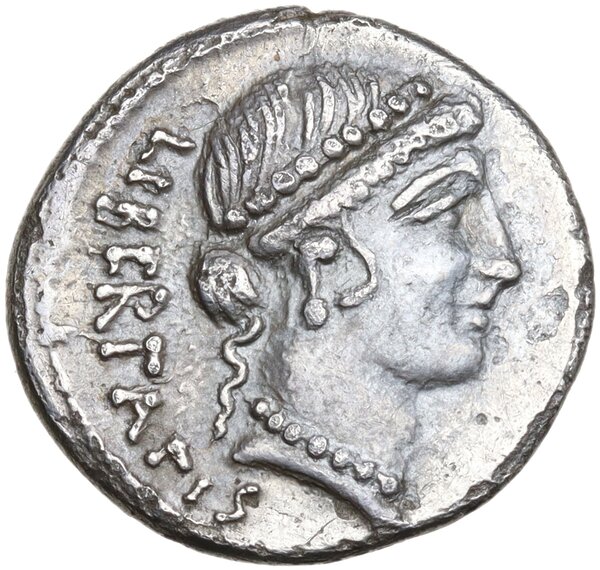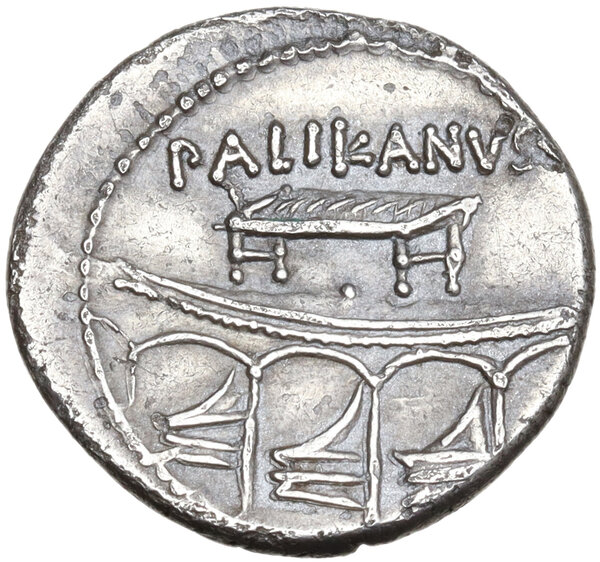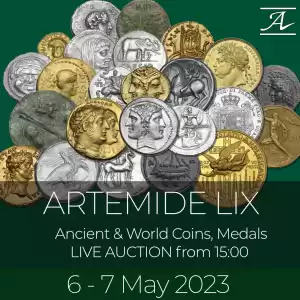The Rostra in the Forum


Lollius Palicanus. AR Denarius, 45 BC. Obv. Head of Liberty right; behind, LIBERTATIS. Rev. View of the Rostra in the Forum surmounted by a sella; above, PALIKANVS. Cr. 473/1; B. 2. 3.90 g. 18.00 mm. R. A choice example of this rare and very interesting issue, sharply struck, brilliant and superb. About EF/EF. The Rostra is the name of the great speaker's platform in the Forum, from which speakers addressed crowds, and from this platform many of the great and famous speeches in Roman history were delivered. Initially, it was constructed as a flat-topped platform (suggestus) forming part of the large, round Comitium (an area in front of the Curia where speakers would address the whoever was assembled). Typically, a speaker's platform is called a tribunal, but after Duilius won Rome's first major naval victory against Antium in 338 BCE, six bronze prows of enemy ships were attached to the front of the speaker's platform as trophies; the Latin for prows is rostra, and the name became used for the entire structure. In 260 BCE, C. Duilius Nepos defeated the Carthagians at Mylae, and replaced or supplemented the original prows with new ones from ships captured in that battle. Eventually, decorative prows that were not from actual ships were specially constructed for the platform itself.
In his plans to rebuild the Curia, which burned down in 52 BCE, Caesar planned to detach the Rostra from the Comitium and reconstruct the platform along the main axis of the Forum. This project was eventually carried out under Augustus. This new orientation turned the Rostra into the northwest border of the Forum Romanum, from which one would see a panorama of the Forum toward the eastern border, formed by the Temple of Caesar, the Temple of Vesta and the Palatine, and the Temple of Castor.
At the back of the Rostra, curved steps led up to the top; the top became so cluttered with statues and memorials, that the Senate several times declared that the owners had to remove them or they would be hauled away! The sides were topped by balustrades with some interesting reliefs, but the front was mostly open. There is a famous relief showing the Rostra with the emperor Trajan participating in a public ceremony. Pliny tells of a crow that used to sit on the Rostra and greet the Emperor Tiberius by name.
In his plans to rebuild the Curia, which burned down in 52 BCE, Caesar planned to detach the Rostra from the Comitium and reconstruct the platform along the main axis of the Forum. This project was eventually carried out under Augustus. This new orientation turned the Rostra into the northwest border of the Forum Romanum, from which one would see a panorama of the Forum toward the eastern border, formed by the Temple of Caesar, the Temple of Vesta and the Palatine, and the Temple of Castor.
At the back of the Rostra, curved steps led up to the top; the top became so cluttered with statues and memorials, that the Senate several times declared that the owners had to remove them or they would be hauled away! The sides were topped by balustrades with some interesting reliefs, but the front was mostly open. There is a famous relief showing the Rostra with the emperor Trajan participating in a public ceremony. Pliny tells of a crow that used to sit on the Rostra and greet the Emperor Tiberius by name.


